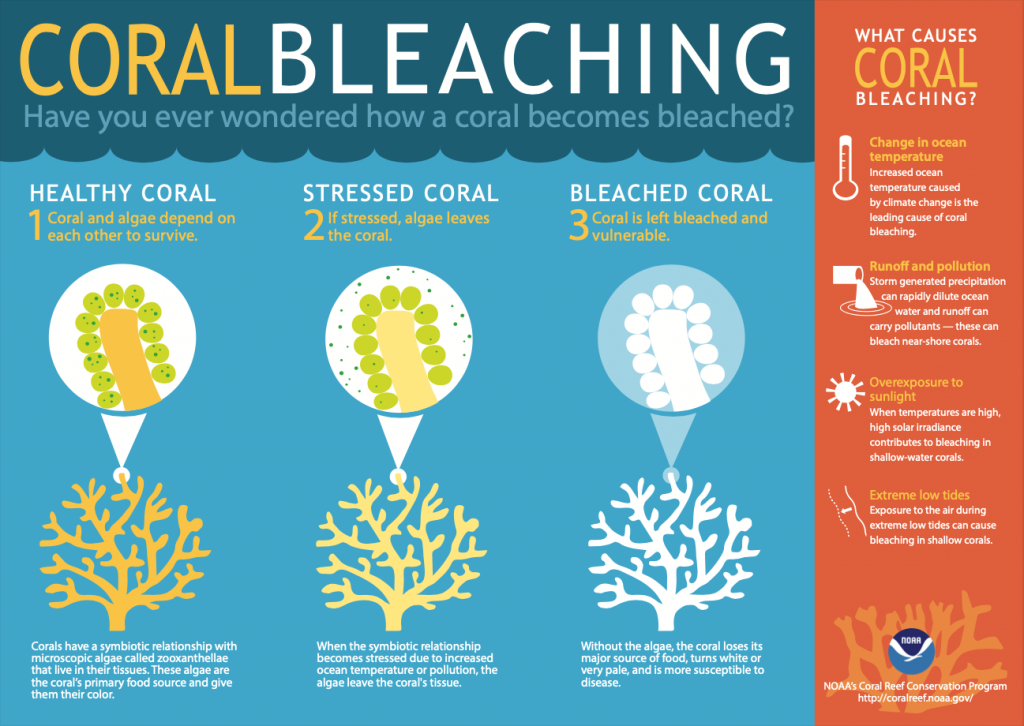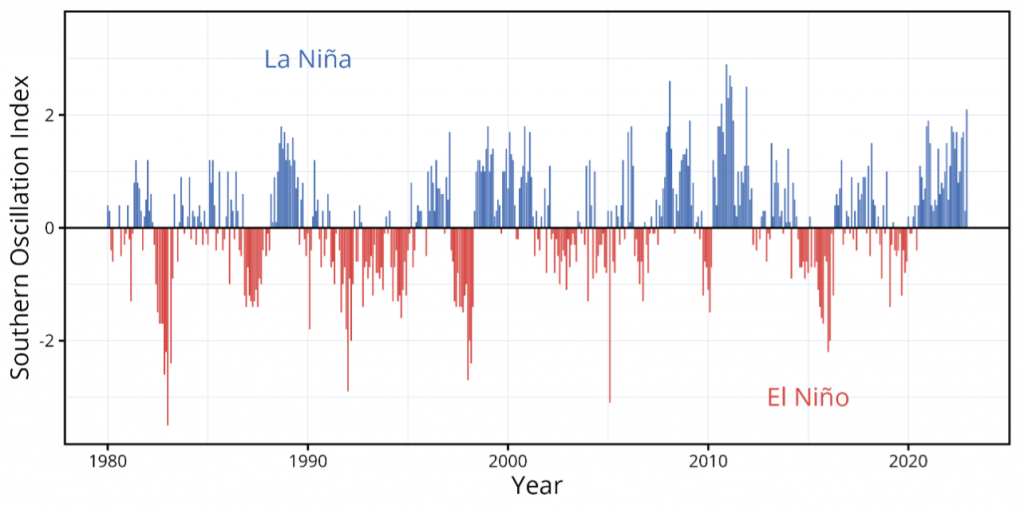Hard corals are particularly sensitive to marine heatwaves (a period of abnormally high ocean temperatures), as thermal stress can lead them to expel their symbiotic algae – zooxanthellae -, revealing their white calcium carbonate structure, a phenomenon called “coral bleaching”. As hard corals heavily depend on the energetic resources provided by their symbiotic algae, marine heatwaves can lead to starvation and potentially to the death of hard coral colonies. Due to climate change, marine heatwaves have increased in intensity, frequency, and size over recent decades, and climatologists predict that this trend will continue [1]. However, the probability that a marine heatwave arises, and therefore that a bleaching event occurred, does not evolve linearly over time and is often exacerbated by natural climatic variability.

Credit: NOAA Coral Reef Conservation Program. Can coral survive a bleaching event? If the stress-caused bleaching is not severe, coral have been known to recover. If the algae loss is prolonged and the stress continues, coral eventually dies. Download this infographic: In English | In Spanish
Among these natural climatic events, one phenomenon, the El Niño-Southern Oscillation (usually abbreviated by ENSO) has a major role in the occurrence of marine heatwaves. ENSO consists of two alternating phases, El Niño and La Niña, occurring every two to seven years. During La Niña phases, the sea surface temperatures are cooler than average over the equatorial Pacific. On the contrary, during El Niño phase, the sea surface temperatures are warmer than normal [2]. Thus, during El Niño phases there is an increased risk of coral bleaching events. Indeed, mass bleaching events have been observed during El Niño phases, particularly in 1998, 2010, and between 2015-2016 [3], which have resulted in an abrupt decline in hard coral cover on the worlds coral reefs as shown by the “Status and Trends of Coral Reefs of the World: 2020” GCRMN report [4].

The Southern Oscillation Index allows the visualisation of the alternance of El Niño and La Niña phases [5]. On this figure, the recent La Niña phase is visible, as well as the 2015/16 El Niño phase.
Since 2020 the ENSO has been in a La Niña phase, but recently meteorologists have gathered indices that the world will likely enter a new El Niño phase over the next few months [6]. Indeed, NOAA issued an El Nino watch that states from November 2023 to January 2024, there is an 80% chance of an, at least, moderate El Nino and 55% chance of a strong phase (however, there is a 5-10% chance that El Nino will not materialize) [7]. This would constitute a serious threat to coral reefs, particularly in the context of climate change.
Data acquired by monitoring programs across the world and analyzed in the frame of large-scale synthetic studies, such as the Status of Coral Reefs of the World: 2020 report published by the GCRMN (e.g. 4), will allow to estimate the impact of this possible new El Niño phase on hard coral cover of coral reefs of the world.
References
[1] Sen Gupta, A., Thomsen, M., Benthuysen, J. A., Hobday, A. J., Oliver, E., Alexander, L. V., … & Smale, D. A. (2020). Drivers and impacts of the most extreme marine heatwave events. Scientific reports.
[2] World Meteorological Organization. https://public.wmo.int/en/about-us/frequently-asked-questions/el-ni%C3%B1o-la-ni%C3%B1a. Consulted on 2023-05-29.
[3] Skirving, W. J., Heron, S. F., Marsh, B. L., Liu, G., De La Cour, J. L., Geiger, E. F., & Eakin, C. M. (2019). The relentless march of mass coral bleaching: a global perspective of changing heat stress. Coral reefs.
[4] Souter, D., Planes, S., Wicquart, J., Logan, M., Obura, D., Staub, F. (eds) (2021). Status of coral reefs of the world: 2020 report. Global Coral Reef Monitoring Network (GCRMN) and International Coral Reef Initiative (ICRI). DOI: 10.59387/WOTJ9184
[5] National Oceanic and Atmospheric Administration. Southern Oscillation Index (SOI). https://www.ncei.noaa.gov/access/monitoring/enso/soi. Consulted on 2023-05-29.
[6] World Meteorological Organization. https://public.wmo.int/en/our-mandate/climate/el-ni%C3%B1ola-ni%C3%B1a-update. Consulted on 2023-05-29.
[7] National Weather Service, Climate Prediction Center. El Niño/Southern Oscillation (ENSO) Diagnostic Discussion. 11 May 2023. https://www.cpc.ncep.noaa.gov/products/analysis_monitoring/enso_advisory/ensodisc.html . Consulted on 2023-06-06.





